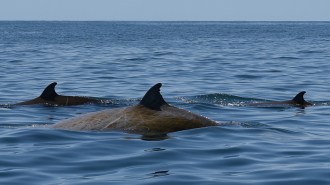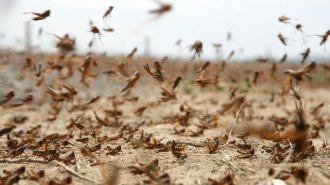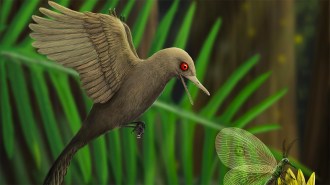Search Results
Gibbons learn the ropes
Students will answer questions about the online Science News article “A rope bridge restored a highway through the trees for endangered gibbons,” which describes how researchers helped critically endangered Hainan gibbons in China navigate a gully after a landslide. A version of the story, “A rope bridge restored an ape highway,” can be found in the November 21, 2020 issue of Science News.

Whale’s Breathtaking Dive Impresses
In this guide, students will learn about the extraordinary diving ability of the Cuvier’s beaked whale and what scientists think allows the marine mammal to stay underwater for extended periods. Then, students will discuss the ocean zone model and research the environment and species of a specific ocean zone.
Zone in on the ocean
Students will explore how the ocean environment changes with depth and how various organisms’ physical traits allow the organisms to thrive at different depths. Students then will discuss the benefits and limitations of the ocean zone model.
Getting deep with the ocean’s master divers
Students will answer questions about the online Science News article “A beaked whale’s nearly 4-hour-long dive sets a new record,” which describes a new record for longest dive by a marine mammal, set by the Cuvier’s beaked whale. A version of the story, “Whale’s breathtaking dive impresses,” can be found in the November 7, 2020 issue of Science News.

Chemical Coaxes Locusts to Swarm
In this guide, students will learn how a newly identified pheromone may influence species behavior, research a pheromone that interests them and discuss why scientists are interested in studying such chemicals.
Chemicals cue behavior
Students will explore the chemical makeup of pheromones, how the chemicals may cue species behavior and why it’s important for scientists to study such information. Students will answer questions related to the pheromone discussed in the Science News article before applying the same questions to a pheromone of their choice.
The science of locust swarms
Students will answer questions about the online Science News article “A single molecule may entice normally solitary locusts to form massive swarms,” which describes a compound used in locust congregation that might also be used to control the pests. A version of the story, “Chemical coaxes locusts to swarm,” can be found in the September 12, 2020 issue of Science News.

Calculating a Dog’s Age Requires a Bit More Math
In this guide, students will learn how scientists used molecular biology to rethink a popular mathematical formula for finding a dog’s age in human years. Students will then analyze and discuss mathematical models.
Mathematical models of a dog’s age
Students will define, apply and analyze a new mathematical model for determining dog age in human years before comparing it to an old version of the model. Then, students will give examples of mathematical models in other fields and think about models’ benefits and limitations.
Old dog, new math
Students will answer questions about the online Science News article “Calculating a dog’s age in human years is harder than you think,” which explores how scientists used molecular biology to more accurately compare canine aging with human aging. A version of the story, “Calculating a dog’s age requires a bit more math,” can be found in the August 15, 2020 issue of Science News.

A Tiny Dino and Iron Rain
In this guide, students will learn about the smallest-known Mesozoic dinosaur and use phase diagrams to explore meteorology on an exoplanet. In an activity, students will collect and analyze data in their own homes. Editor’s Note: A study included in this guide has been retracted. Please see the comprehension questions for more detail.
Sizing up a dinosaur
Students will answer questions about the Science News article “This ancient dinosaur was no bigger than a hummingbird,” which reports on a fossil of a many-toothed, Mesozoic predator.